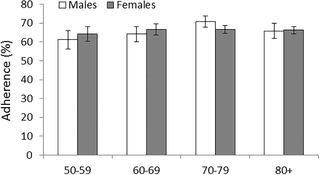PLOS ONE ( IF 3.7 ) Pub Date : 2018-01-12 , DOI: 10.1371/journal.pone.0191185 Stefanie Frech 1 , Daniel Kreft 2, 3 , Rudolf F Guthoff 1 , Gabriele Doblhammer 2, 3, 4

|
The goal of this study was to assess the adherence of primary open-angle glaucoma (POAG) patients to medication, and to determine co-factors influencing adherence, using a representative sample of members of the largest German public health insurer. The observational cohort study was based on a longitudinal data set from 2010–2013 and included 250,000 insured persons aged 50 and older with 10,120 diagnosed POAG patients. Uni- and multivariate analysis was performed to investigate several aspects of glaucoma, such as prevalence, adherence, and co-factors influencing adherence. The main outcome measured adherence with prescriptions filled within a year. Multivariate panel regression analysis was used to determine the co-factors influencing this adherence. Prevalence of POAG was 3.36% [CI: 3.28–3.43%], with 2.91% [CI: 2.81–3.01%] for males and 3.71% [CI: 3.61–3.81%] for females, increasing with age. The mean level of adherence in terms of prescriptions filled was 66.5% [CI: 65.50–67.60%]. The results of this analysis revealed a significant influence of age, duration of the disease, care need, distance to death, and multimorbidity as co-factors of non-adherence, whereas gender had no influence. The analysis provided detailed information about POAG health care aspects concerning prevalence and adherence. The most endangered risk groups for non-adherence were patients aged 50–59, patients older than 80 years, patients with a longer duration of POAG, patients with care needs, and patients with three or more severe diseases in addition to glaucoma. To know the predictors responsible for an increased risk to develop POAG is of importance for all persons involved in health care management. Therefore effective strategies to increase awareness of patients and medical care personnel about non-adherence and the importance of a regular and continuous medication to avoid further nerve fiber damage and possible blindness have to be developed.
中文翻译:

原发性开角型青光眼患者依从性和影响辅助因素的药物流行病学评估——一项观察性队列研究
本研究的目的是使用德国最大公共卫生保险公司成员的代表性样本,评估原发性开角型青光眼 (POAG) 患者对药物的依从性,并确定影响依从性的辅助因素。这项观察性队列研究基于 2010 年至 2013 年的纵向数据集,包括 250,000 名 50 岁及以上的参保人,以及 10,120 名诊断为 POAG 的患者。进行单变量和多变量分析以调查青光眼的几个方面,例如患病率、依从性和影响依从性的辅助因素。主要结果衡量一年内配药的依从性。使用多变量面板回归分析来确定影响这种依从性的辅助因素。POAG 的患病率为 3.36% [CI: 3.28–3.43%],其中男性为 2.91% [CI: 2.81–3.01%],女性为 3.71% [CI: 3.61–3.81%],且随着年龄的增长而增加。就配药而言,平均依从率为 66.5% [CI: 65.50–67.60%]。该分析的结果显示,年龄、疾病持续时间、护理需求、死亡距离和多重发病率作为不依从性的辅助因素具有显着影响,而性别则没有影响。该分析提供了有关 POAG 医疗保健方面的患病率和依从性的详细信息。不依从性最危险的风险群体是50-59岁的患者、80岁以上的患者、POAG持续时间较长的患者、有护理需要的患者以及除青光眼外还患有三种或以上严重疾病的患者。了解导致 POAG 风险增加的预测因素对于所有参与医疗保健管理的人员都很重要。因此,必须制定有效的策略来提高患者和医疗人员对不依从性的认识,以及定期和持续用药的重要性,以避免进一步的神经纤维损伤和可能的失明。



























 京公网安备 11010802027423号
京公网安备 11010802027423号